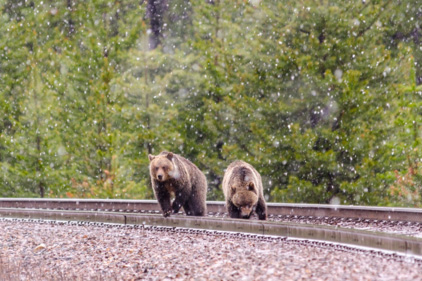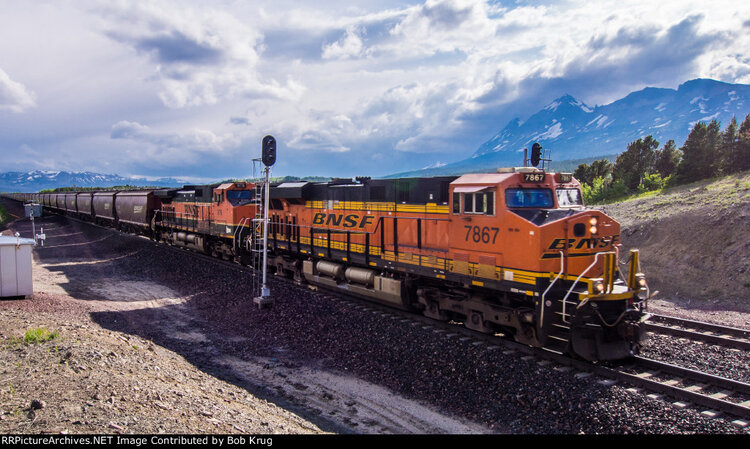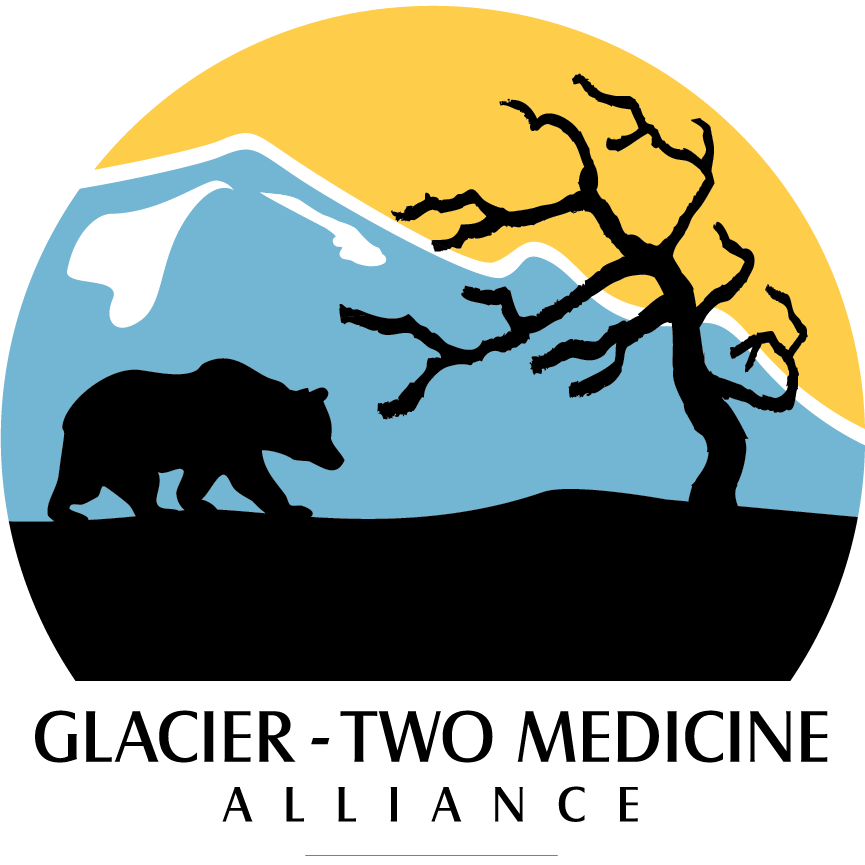Help Improve the Railroad’s Grizzly Bear Plan
Last month, after years of wrangling and delay, the Burlington Northern Santa Fe railroad finally submitted a formal Habitat Conservation Plan to the U.S. Fish and Wildlife Service which outlines the measures the company will take to reduce the impact of its operations on grizzly bears in a 206 mile corridor between Shelby and Sryker.

We encourage you to submit comments on the plan before 11:59 p.m. Eastern on Thursday, Feb. 11th deadline.
Comments can be submitted online or mailed to:
U.S. Fish and Wildlife Services Headquarters
Public Comments Processing
Attn: Docket No. FWS-R6-ES-2019-0010
5275 Leesburg Pike
Falls Church, VA 22041-3803.
Why This Matters
Freight and passenger trains chugging past the southern boundary of Glacier National Park continue to pose a major threat to the recovery of grizzly bears in region, accounting for 11% of all human-caused grizzly bear deaths in the region over the past 28 years. Typically, such deaths occur when bears are attracted to the right-of-way to feed on spilled grain, wildlife or livestock carcasses, human garbage, or seasonal vegetation growing near the tracks.
Limiting the number of bears killed by people, including with trains, is critical to the successful recovery of grizzly bears. Glacier-Two Medicine Alliance believes the commitments outlined in the HCP will aid in that effort. For that, BNSF deserves to be commended. However, we believe there are a number of reasonable changes the company should make to the plan before it is approved.
What does the HCP do?
The HCP lays out a series of actions that BNSF agrees to take to limit and mitigate the impacts of its operations on grizzly bears. In exchange, BNSF will receive an Incidental Take Permit to inadvertently kill upwards of 18 bears over the next seven years.
As part of the plan, the railway will continue to implement 13 existing “minimization measures” that have been successful at limiting the number of bears killed by trains. Several of these measures ensure grizzly bear strikes are documented and investigated properly. The remainder layout procedures for reducing or removing attractants that draw bears to the railway right-of-way, such as minimizing and rapid clean-up of grain spillage, monitoring and removing animal carcasses, preventing the spillage of human garbage, and managing certain vegetative food sources.
 The HCP also establishes a mitigation program to offset the loss of female grizzly bears that are killed by trains. Females account for a disproportionate number of train-caused mortalities and their loss is particularly problematic to maintaining a viable bear population. The primary mitigation measure is funding for three grizzly bear technicians – two for Montana Fish, Wildlife and Parks, and one for the Blackfeet Nation. BNSF will also contribute additional funds to grizzly management, including for radio collars ($60,000), remote cameras ($20,000), bear resistant garbage containers ($30,000), fencing ($88,000), and bear hunter education ($11,000).
The HCP also establishes a mitigation program to offset the loss of female grizzly bears that are killed by trains. Females account for a disproportionate number of train-caused mortalities and their loss is particularly problematic to maintaining a viable bear population. The primary mitigation measure is funding for three grizzly bear technicians – two for Montana Fish, Wildlife and Parks, and one for the Blackfeet Nation. BNSF will also contribute additional funds to grizzly management, including for radio collars ($60,000), remote cameras ($20,000), bear resistant garbage containers ($30,000), fencing ($88,000), and bear hunter education ($11,000).
The HCP will be administered by the Montana Outdoor Legacy Foundation, the foundation arm of MFWP. A technical committee comprised of representatives from BNSF, Amtrak, MFWP, and the Blackfeet Nation will monitor and review compliance. Crucially, if grizzly bear mortality exceeds plan thresholds for two consecutive years, the technical committee may require additional mitigation and minimization steps to be taken, financed by a $1 million reserve fund BNSF will create.
Our Assessment
While there are a lot of improvements we’d like to see, the HCP should, on the whole, benefit grizzly bear recovery efforts. The railroad’s commitment to maintain current practices should help keep the number of bears hit by trains at the lower levels seen in recent years (save for 2019), levels the population has demonstrated it can withstand.
The best part of the plan is the guaranteed funding BNSF will provide for three grizzly bear technicians. The lack of reliable funding for such positions has continually hindered grizzly bear recovery. These additional positions will help FWP and the Blackfeet Nation limit conflicts and improve coexistence between bears and people, particularly in areas where grizzlies are expanding their range. We also appreciate adaptive management approach that allows plan modifications based on monitoring mortality incidents, as well as the inclusion of $1 million reserve fund that can finance additional actions that may be necessary to limit grizzly mortality.
That said, we find the mortality thresholds in the plan deeply troubling. Under the plan, trains could kill 2.6 bears per year, which is an increase from the 2.1 bears trains have typically killed per year over the past 15 years. You read that right—a plan designed to limit grizzly bear mortality actually permits higher mortality.
The plan’s other mortality thresholds—train-caused deaths will account for no more than 12% of all human caused mortality in the NCDE or 22% of all human caused female mortality—are (with a couple exceptions) also substantially higher than the level attributed to trains during the last 15 years. The plan suggests these higher thresholds are warranted because the NCDE grizzly population as a whole is growing. However, no evidence about the grizzly population in the corridor – the bears most likely to be hit – is referenced. While such finer scale population data is limited, recent population analyses conducted by the US Geologic Survey suggest bear density in the corridor is most likely stable, not increasing, especially in areas around Glacier National Park. Thus, we are worried the plan could lead to elevated levels of female mortality in the core of the grizzly population without triggering corrective action.
Suggestions for Improvement
Here are our top five ways to improve the HCP.
#1 — Tighten Incidental Take Thresholds – The Incidental Take Thresholds (p. 28) should be adjusted to reflect more recent historical trends. The inclusion of data from the 1990s and early 2000s, when grain spills and grizzly deaths were higher, improperly inflates the thresholds because it does not reflect reasonably foreseeable future conditions. If BNSF truly wants to be a good corporate citizen and partner in grizzly bear recovery efforts, it should not ask for a permit that allows for an increase in take above recent historical levels.
#2 — Greater Public Accountability – We’d like to see better public accountability measures built into the plan. All MOLF and/or technical committee meetings should be open to the public and any data collected, as well as reports or other documents produced through HCP implementation should be made available on the MOLF website for public review. This would help BNSF showcase the good work it is doing as well as instill public trust and confidence in the process. To that end, we further suggest an independent, grizzly bear biologist as well a member of the public knowledgeable about grizzly bear policy and management be included on the committee.
#3 - Faster Livestock Exclusion – In MN-9 (p. 38) the company commits to work with adjacent ranchers and landowners to control livestock “if a pattern of livestock collisions is identified.” While the approach is right, the language is too vague and reactionary. The company should proactively work with ranchers and landowners to identify areas where cattle can access the tracks and then take steps prevent that access before a cow becomes a carcass. Furthermore, any fencing improvements warranted need to happen as soon as practicable, not within the one year of an incident as the plan currently allows.
#4—Monitor Wildlife Loss -- In MN-10 & MN-11 (p. 39), the railway makes positive commitments to remove wildlife carrion from the right of way as well as to conduct a spring sweep for any carcasses missed over the winter. We suggest that BNSF should, as a part of this process, also document the location and species of all carcasses. This data could identify any hotspots where wildlife is routinely struck and help inform additional measures that could be taken both to reduce the availability of these attractants for bears as well as to minimize the loss of wildlife to railroad operations generally.
#5 —Commit to Potential Operational Adjustments – A major limitation of the HCP is the outright dismissal of any potential operational changes to the railroad beyond a vague commitment to “explore new technologies” to prevent bears from accessing the track where escape is difficult. Research in Banff National Park, Canada – where train strikes are also a major issue – indicates grizzly mortality is closely associated with train speed and track curvature (i.e. sight and sound distance) and that reducing speeds in places and times where bears are active, or installing early warning systems that alert bears to oncoming trains, can reduce mortality. In the event mortality thresholds are exceeded for two consecutive years, the HCP should authorize the technical committee to consider, and require if warranted, these types of adjustments in order to limit future mortality.
Thank you for taking time to comment in support of grizzly bear recovery.
